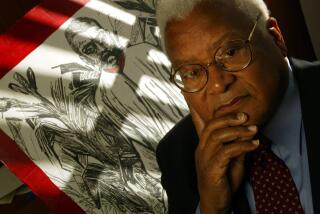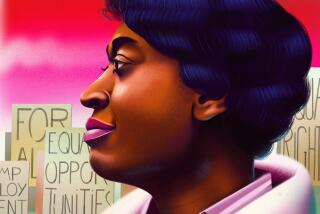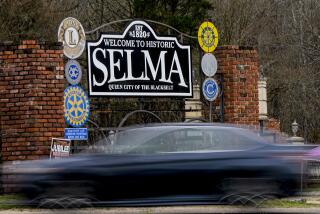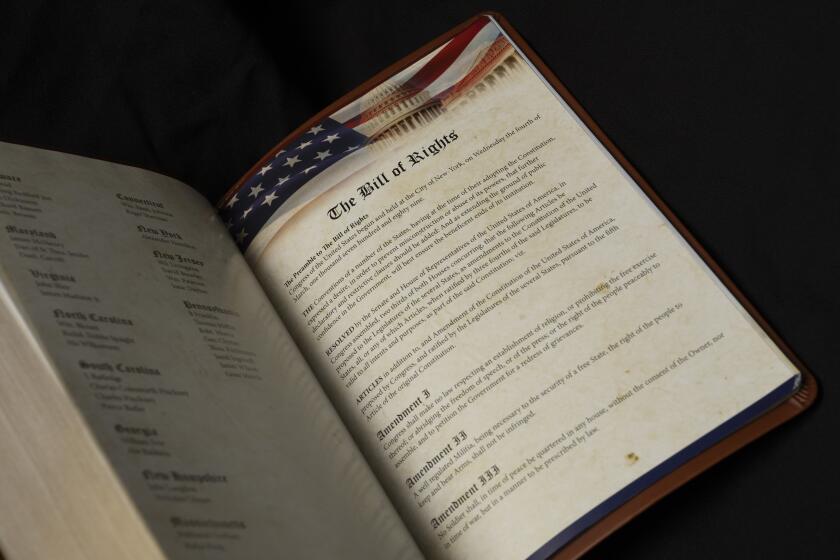Triumphant voices of history
If not for the tape recorder beside her, Gwendolyn Britt might have remained another anonymous character in the civil rights story: the sit-ins, the freedom rides, the picket lines, the police. She was there. She saw it. She may not be in high school history textbooks, but you get the idea.
Or do you? The American Assn. of Retired Persons and the Leadership Conference on Civil Rights want to make sure that detailed, compelling narratives survive the movement’s aging participants. So they plan to create a permanent, comprehensive archive of the civil rights struggle of the 1960s, while they still can. Between now and Oct. 16, volunteers will ride a bus across the country, interviewing participants in the movement and compiling the country’s largest collection of firsthand accounts, which will be cataloged online at www.voicesofcivilrights.org and held in the Library of Congress.
There is some degree of urgency here. Half a century after the Supreme Court outlawed school segregation in Brown vs. Board of Education, most of that era’s civil rights activists qualify for social security. If this week has been any indication, they are eager to get memory on tape. Britt, who is 62, was one of a dozen or so who told their stories on the Mall as the 35-city bus tour called “Voices of Civil Rights” was launched.
The bus will visit cities that became flashpoints in the civil rights movement: Little Rock, Ark., where federal marshals escorted nine black students into the all-white Central High School in 1957; Greensboro, N.C., where four black students held the first sit-in at a Woolworth’s lunch counter in 1960; Jackson, Miss., where 37-year-old Medgar Evers was murdered in 1963 by a mob outside his home; Memphis, where Martin Luther King Jr. was shot in 1968.
“Sometimes I sit down and try to think back to those days,” Britt says, “how it felt to be there at the time.” She has trouble remembering exactly, she says, but recalls it was something like this: She was 19 years old and feeling brave in 1960, when she joined the D.C. Nonviolent Action Group. It was a hot summer in Northeast Washington, where she grew up, and she should have been going to college, preparing for law school. But the careening D.C. civil rights movement pulled her off course. “This is something I’ve gotta do,” she thought. So she did.
It started at the lunch counters at Woolworth’s and Drug Fair in Arlington and Fairfax -- “my baptism” into the movement in 1960, she says. In mixed-race groups of five, six or seven, they would sit down and wait for a waitress to close the counter and call the police. Britt was arrested four or five times in a single year. The charge was trespassing.
She tells this story to Vernon Smith, a volunteer interviewer who himself participated in the civil rights movement in Mississippi, while the two sit at a plywood mock-up lunch counter designed to look like it’s straight out of Britt’s stories. This is one of several evocative backdrops that the “Voices of Civil Rights” people built in the interview tent. It has a black-and-white checkered tile floor, a chrome mini-jukebox playing other civil rights testimonials, a straw dispenser filled with pens, and a plastic burger basket with an assortment of stickers that say “I told my story.”
Funny how things change, Britt observes. She is now a state senator in Maryland. She finally finished her bachelor’s degree in political science this year.
Her husband, Travis, whom she met while picketing the Department of Justice, is a smartly dressed 70-year-old man with trifocal sunglasses and a black-and-white polka dot tie that matches his wife’s dress. One day as he stood next to civil rights leader Bob Moses outside a courthouse in Liberty, Miss., a white man tried to persuade a mob to lynch him. Britt stood still as the man, after getting no response, decided to pummel him single-handedly. “Don’t fight back,” Moses told him that day, “and don’t let him knock you down. Every time he hits you, think about the good things in life.”
These are the details history would swallow. No one caught that mob on camera, nor the itinerant farmers Britt had tutored so they could register to vote. Not many know that the couple spent 40 days and nights on mattresses in Parchman Penitentiary after refusing to leave the train station in Jackson, Miss., their destination on a freedom ride from New Orleans.
Few have heard of Betty Bunce, a retired first-grade teacher living in Baltimore who continued to teach when federal marshals brought three little black girls to her New Orleans public school, McDonogh #19. And there are scant well-known stories of Wade Henderson, the executive director of the Leadership Conference on Civil Rights, who went to the same D.C. high school as Gwendolyn Britt and grew up frustrated and confused because he wasn’t allowed into local amusement parks and swimming pools.
The “Voices of Civil Rights” project emphasizes that the movement is a lot of individual stories of bravery that happened concurrently. But in the popular consciousness, the diversity of history is often subsumed by the familiar.
We may not know Travis Britt, but we do know Medgar Evers. We may not know Bunce, but we do know the Little Rock Nine. We may not know Henderson, but perhaps we should.
Henderson, 56, was 15 years old in 1963, when he went to Garfinkel’s department store to buy a navy blue suit for his ninth-grade graduation. The wad of money he carried to the store that day came from a paper route, and the innocence from years of living in a segregated black community in downtown Washington. He asked a sales clerk for a dressing room.
“No Negroes can try on clothes in Garfinkel’s,” the clerk responded, as Henderson remembers it. Then he was kicked out of the store, no suit, no pride, no more illusions of racial equality.
That summer, despite his parents’ orders to stay home, Henderson took the bike he used to deliver newspapers and rode to the Mall to participate in the March on Washington. “I was really in awe of what I saw that afternoon,” Henderson says.
The march, capped off by Martin Luther King Jr.’s famous “I have a dream” speech, stoked a fire that for Henderson began at Garfinkel’s. It was the hottest day of the summer, he says, but civil rights activists were wearing suits and ties. It was the beginning of his understanding of the struggle for equality.
“Having seen the duality of a world that was the official world of power, but also a world that was closed to people like me,” he says, he became committed to righting wrongs and to making sure his story -- and every story -- had a chance to be heard.
More to Read
Sign up for Essential California
The most important California stories and recommendations in your inbox every morning.
You may occasionally receive promotional content from the Los Angeles Times.










